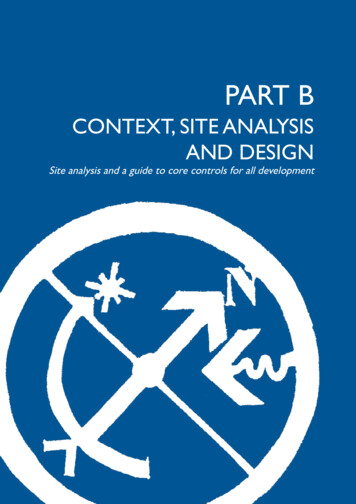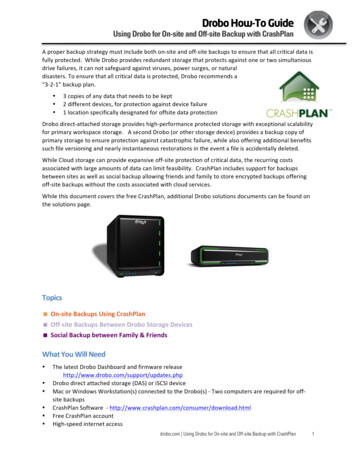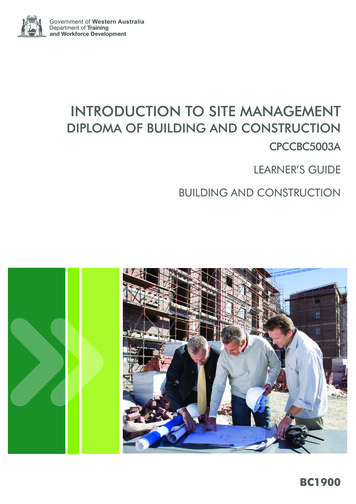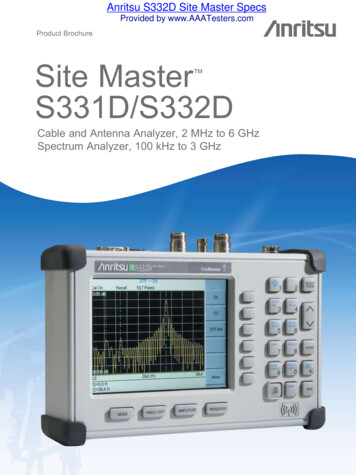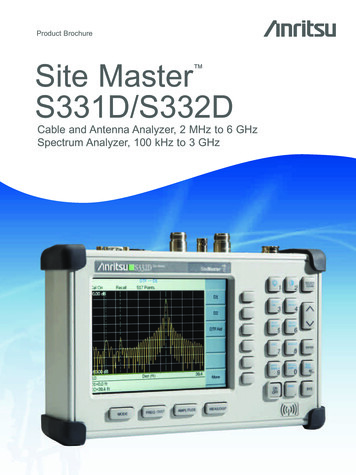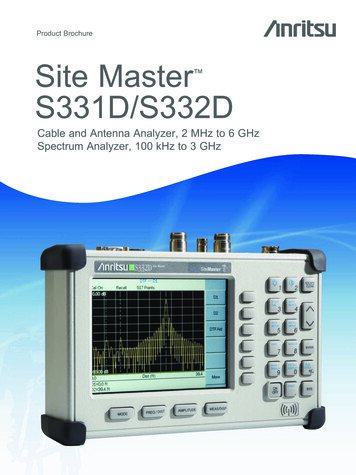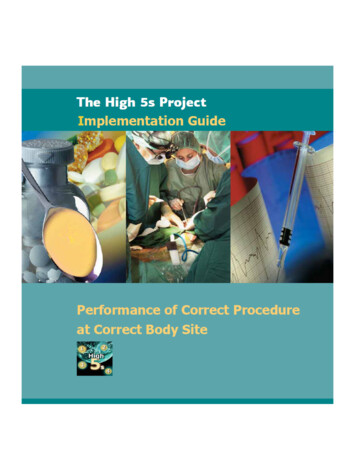
Transcription
orrect Body Site:
Implementation Guidefor Implementing the Standard Operating Protocol forPerformance of Correct Procedure at Correct Body SiteThe High 5s Project“Correct Site Surgery”Attribution StatementThis work was carried out as part of the High 5s Project set up by the World Health Organization in2007 and coordinated globally by the WHO Collaborating Centre for Patient Safety, The JointCommission in the United States of America, with the participation of the following Lead TechnicalAgencies including: Australian Commission on Safety and Quality in Health Care, Australia; CanadianPatient Safety Institute, Canada and the Institute for Safe Medication Practices Canada, Canada;National Authority for Health- HAS, France, with CEPPRAL (Coordination pour L’ Evaluation despratiques professionnelles en santé en Rhône-Alpes), France, OMEDIT Aquitaine (Observatoire duMedicament, Dispositifs medicaux et Innovation Therapeutique), France (from 2012- 2015) andEVALOR (EVAluation LORraine), France (from 2009-2011); German Agency for Quality inMedicine, Germany and the German Coalition for Patient Safety, Germany; CBO Dutch Institute forHealthcare Improvement, the Netherlands; Singapore Ministry of Health, Singapore; Trinidad andTobago Ministry of Health, Trinidad & Tobago; Former National Patient Safety Agency, UnitedKingdom of Great Britain and Northern Ireland; and the Agency for Healthcare Research andQuality, USA.This work is a part of the High 5s Project which has been supported by the Agency for HealthcareResearch and Quality, USA, WHO, and the Commonwealth Fund, USA.The Implementation Guide was developed, tested and refined within the context of the High5sProject, an internationally coordinated, participation activity for testing the feasibility ofimplementing standardized patient safety protocols and determining the impact of theimplementation on certain specified patient safety outcomes.The High 5s Project – Correct Site Surgery, Implementation GuidePage ii
Table of ContentsIntroduction .1Overview of Correct Site Surgery (CSS) . 3What Do We Mean by Correct Site Surgery?. 3What Has Been the Impact of the High 5s Initiative for Correct Site Surgery? . 3Where Do Activities to Promote Correct Site Surgery Take Place ? . 4Who Should Be Involved in Efforts to Promote Correct Site Surgery? . 4The High 5s Standard Operating Protocol (SOP) for Correct Site Surgery . 5The SOP At-a-Glance . 5The Correct Site Surgery Processes . 6Flow diagrams of the Correct Site Surgery Processes . 7The Preoperative Verification Process . 11Surgical Site Marking .12The Final 'Time Out' Verification .13Guidelines for Integrating the High 5s CSS SOP into Exisiting Pre-op Procedures .15How Does the High 5s CSS SOP Relate to the WHO Safe Surgery Saves Lives Initiative? .16The High 5s Preoperative Verification Check List for Correct Site Surgery . 18The Basic High 5s Preoperative Verification Check list .18Item-by-Item Tips for Completing The High 5s CSS Check List .19Guide to Combining the High 5s Pre-op Verification Check List with Existing Pre-op Tools . 24Implementing the High 5s SOP for Correct Site Surgery. 25Quick-Start Check List — Are You Ready? . 25The Implementation Team . 26Constructing a Detailed Implementation Work Plan . 28What are the required tasks for a successful implementation? . 28Who Does What? . 28What Is the Time Line? . 29What are the Deliverables & Milestones? . 29What are the Dependencies and Critical Path? . 29Template Work Plan . 30Risk Assessment of the Preoperative Preparation Process . 32Principles for Safe and Reliable Preoperative Preparation Process . 36Pilot Testing the SOP . 37Adaptation of the SOP . 37Progressing to Full Implementation . 37Maintaining and Improving the Process. 38Process Management, Evaluation and Feedback . 39SOP Implementation Experience . 40Performance Measures . 44Event Analysis . 52Appendix 1: Examples of Consolidated Check Lists . 57Appendix 2: High 5s Event Analysis Reporting Form . 73Appendix 3: Frequently Asked Questions (FAQs) and Answers . 83Appendix 4: List of Resources . 86The High 5s Project – Correct Site Surgery, Implementation GuidePage iii
IntroductionThis Implementation Guide is intended to assist front line hospital staff and leaders to achieve a smooth and successfulimplemention of the High 5s Correct Site Surgery Standard Operating Protocol (SOP). It will describe the continuingproblem of wrong person, wrong procedure, wrong site sugery and what can be done to reduce the risk of thesepreventable events. It will then provide the tools and procedures for implementing the SOP in an efficient andeffective manner and for determining the success of the implementation and of the impact on reducing the risk ofincorrect surgery. A considerable portion of this Implementation Guide will be devoted to the use of a PreoperativeVerification Check List as a tool for implementing the SOP in a consistent manner, for documenting completion of thesteps in the SOP, and for collecting useful data in real time to enable efficient and effective implementation of theSOP.A Word about StandardizationThe basic assumption that was tested in the High 5s initiative is that process standardization will improve patientsafety. We know that in a general sense, the tendency for a process to fail is diminished in relation to the consistencywith which it is carried out; that is, the degree to which it is standardized. Despite this, efforts in recent years tostandardize health care processes through the introduction of practice parameters, protocols, clinical pathways, and soforth have been met with limited enthusiasm among practitioners and are only slowly affecting the actual delivery ofcare. Achieving process consistency while retaining the ability to recognize and accommodate variation in the input tothe process (for example, the patient’s severity of illness, co-morbidities, other treatments, and preferences) is one ofthe major challenges to standardization in health care. Process variation to meet individual patient needs is an essentialprinciple of modern medicine; variation to meet individual health care organization or practitioner preferences neednot be. The thesis that has been tested in the High 5s initiative is that standardization will be advantageous—will getbetter overall results more safely—even if we concede that each practitioner working independently could get better resultsthan the others by using a personally favored, but different, process than the others. The reason, of course, is that inmodern medicine, practitioners do not work independently. Clinical results are determined by the complexinterrelationships among practitioners, supporting staff and services, and the clinical environment. Assuming eachpreferred practice is a good practice, it matters less which process is selected as the basis for standardization; it is thestandardization that matters most. Standardization produces better results than a variety of “best practices” when itcomes to safety.The High 5s initiative has taken standardization a couple of steps further than the usual efforts to minimize variation—it not only sought to standardize certain processes among individuals within a health care organization but tostandardize them in multiple organizations in multiple countries around the world. The High 5s Project posed thefollowing questions: Is it possible to standardize on a multinational scale? If it is, will this effort measurably improvethe safety of care? The first of these questions has now been answered as a qualified affirmative. That is, the High 5sProject has demonstrated that a standardized process for preparing patients for surgery, focused on the prevention ofwrong site surgery, can be implemented on a multinational scale with minimal adaptation of the protocol. However,while most of the participating hospitals have achieved full implementation of the SOP, some have not and are still inThe High 5s Project – Correct Site Surgery, Implementation GuidePage 1
the process of spreading the implementation to include all eligible sites and patient groups. Also, performance measuredata collected over the course of the Project demonstrates significant variation from hospital to hospital and country tocountry in the consistency of performance of the steps of the SOP. Finally, it should be noted that all but one of theparticipating countries are classified as developed economies. The question of impact is more difficult to answer,primarily because of the infrequency of the events the SOP is intended to prevent, lack of a reliable baseline ofoccurrence rate, and the inconsistency of reporting events that do occur. Nonetheless, while impact in terms of achange in outcomes cannot be demonstrated, there has clearly been an impact on the processes for preparing patientsfor surgery (e.g., evidence of the introduction of surgical site marking where it had not previously been practiced), andon the awareness of and attention to the problem of wrong site surgery and its prevention.The High 5s SOPs are now available for general implementation. In the interest of improving patient safety, WHOencourages Member States to promote implementation of these SOPs in their health care facilities and recommendstheir implementation as written. To do otherwise defeats the purpose and the value of the standard operatingprotocols.The High 5s Project – Correct Site Surgery, Implementation GuidePage 2
Overview of Correct Site Surgery (CSS)What Do We Mean by Correct Site Surgery?“Correct site surgery” means that the correct procedure has been performed on thecorrect patient at the correct anatomical site and, when applicable, using the correctimplant. Conversely, “wrong site surgery,” also called “incorrect surgery,” meanssurgery that has been initiated involving the wrong procedure, wrong patient, wrongCORRECT SITEsite (including wrong side or wrong organ), or wrong implant. Such a procedure isconsidered “incorrect” whether or not a process error has occurred and whether ornot any harm resulted. Use of the term “correct” in this context is in relation to whatwas intended to be done; it is not in any way a clinical judgment about theappropriateness or necessity of the planned procedure.In relation to the 234 million or so major surgical operations that are conducted eachyear, these are infrequent, though not “rare” events. In fact, there has been a steadyincrease in the number of reported cases over the past two decades. This may simplybe a reflection of improved reporting, but the fact remains there is no evidence thatCORRECT PROCEDUREthe incidence or frequency of this problem has decreased in recent years despite theintroduction of relevant international patient safety goals and standards, the UniversalProtocol, the WHO World Alliance for Patient Safety’s Solution #4: Performance ofCorrect Procedure at Correct Body Site, and the WHO 2nd Global Patient SafetyChallenge: Safe Surgery Saves Lives.Considered preventable occurrences, these cases are largely the result ofmiscommunication and unavailable or incorrect information. Detailed analyses ofCORRECT PERSONthese cases indicate that two major factors contributing to error are the lack of astandardized preoperative process and a degree of staff automaticity (checking withoutthinking) in the approaches to the preoperative check routines.What Has Been the Impact of the High 5s Initiative for Correct Site Surgery?The High 5s Correct Site Surgery Standard Operating Protocol (SOP) is one of several standardized protocolsdeveloped specifically:1. to test the feasibility of implementing standardized patient safety protocols within a group of countries that arerepresentative of major regions of the world, and2. To demonstrate the effectiveness of such standardization in reducing the risk of certain types of adverseevents in participating hospitals in these countries.The High 5s Project – Correct Site Surgery, Implementation GuidePage 3
The Correct Site Surgery SOP focuses on reducing the risk of incorrect surgery. To achieve these goals, participatinghospitals were required to adhere to the SOP as written and to measure their performance both in implementing theProtocol and in achieving success in reducing or eliminating wrong site surgery. Preliminary results of the High 5sProject are available in an Interim Report at lutions/high5s/en/Where Do Activities to Promote Correct Site Surgery Take Place ?The principles and detailed procedures of the Correct Site Surgery SOP are applicable wherever surgical and otherinvasive procedures are performed, including procedure units such as endoscopy and catheterization labs, as well asdedicated obstetrical operating rooms and facilities used exclusively for ambulatory surgery. It should include all casesperformed in these settings such as day surgery cases, endoscopies, and other interventional procedures. A hospitalmay initially choose to implement the High 5s procedures and check list in a more limited scope, for example, all casesperformed in the hospital inpatient operating room environment. However, the goal over time should be to achievefull implementation as described above.Who Should Be Involved in Efforts to Promote Correct Site Surgery?Surgery is a team activity. Success depends on the reliable performance of all members of the team as a team. To theextent that each member of the surgical team is seen as an equal partner, each with his or her specific roles,responsibilities and accountabilities; that each can share relevant information freely; is listened to; is respected andsupported by the others—to the extent that this is the prevailing culture, the chances of success are increased. In atypical surgical environment, the team will include the surgeon, one or more assistants, a circulating nurse, one or more“scrub” nurses or technicians, an anesthesia provider and may include other technical support staff and trainees.In addition to this surgical team that functions in the operating room at the time of the operation, there is a larger teamthat supports and provides the preoperative and postoperative care of the patient. All are involved in efforts topromote correct site surgery and other desirable outcomes. The High 5s correct site surgery SOP focuses on thepreoperative—scheduling, admitting, assessing, testing, preparing—team and the intraoperative team.Finally, the SOP includes the role of the most important individual on the team: the patient. The effectiveness of theHigh 5s correct site surgery initiative has been enhanced by participation of the patient and family. This involvementshould be expected and encouraged by engaging them in the informed consent process, involving them in identityverification and surgical site marking, keeping them informed about the preoperative process the patient willexperience, educating them about the risks and what to look for, and providing the means and encouragement toreport any concerns they might have.The High 5s Project – Correct Site Surgery, Implementation GuidePage 4
The High 5s Standard Operating Protocol (SOP) for Correct Site SurgeryThe SOP at-a-GlanceThis Protocol, as for each of the High 5s SOPs, is most easily viewed in “3s.” It has 3 major components:1. The Correct Site Surgery process (This is the standardized process to be implemented)2. The implementation strategy (This is how to implement it)3. The process management strategy (This is the approach to knowing how well you are doing)And each of these 3 components has 3 sections, as follows:1. The Correct Site Surgery Processa. Preoperative verification processb. Surgical site markingc. Final “time out” before surgeryPREOPERATIVEVERIFICATIONOPERATIVE SITEMARKINGFINAL “TIME OUT”VERIFICATION2. The implementation strategya. Planning for implementationb. Pilot testingc. Full implementationPLAN THEIMPLEMENTATIONPILOT TESTFULL IMPLEMENTATION3. The process management strategya. SOP implementation experienceb. Performance measurementc. Event analysisMANAGE THE PROCESSEach of these components and their sections will be explored in greater detail in the following pages.The High 5s Project – Correct Site Surgery, Implementation GuidePage 5
The Correct Site Surgery processesThe consistent achievement of Correct Site Surgery requires a robust approach using multiple, complementarystrategies; the active involvement and effective communication among all members of the perioperative team; theactive involvement, of the patient (or legally designated representative); and the consistent, effective implementation ofthe following three components of the SOP:1. Pre-operative verification processooPurpose: To reduce the risk of patient and procedure misidentification byensuring that all of the relevant documents and diagnostic studies areavailable prior to the start of the procedure; that they are correctlyidentified, labelled, and matched to the patient’s identifiers; and that theyhave been reviewed and are consistent with the patient’s expectations andwith the team’s understanding of the intended patient, procedure, siteand, as applicable, any implants. Missing information or discrepanciesmust be addressed before starting the procedure.Process: An ongoing process of information gathering and verification,beginning with the determination to do the procedure, continuingthrough all settings and interventions involved in the preoperativepreparation of the patient, up to and including the “time out” just beforethe start of the procedure.PREOPERATIVEVERIFICATION2. Marking the operative siteooPurpose: To identify unambiguously the intended site of incision orinsertion.Process: For procedures involving laterality, or multiple structures, surfacesor levels, the intended site must be marked such that the mark will bevisible after the patient has been prepped and draped. Some surgical casesthat meet these criteria for site marking may be exempt from thisrequirement because of special circumstances (see page 13). Cases that areexempt from the site marking requirement are still subject to thepreoperative verification and final time out processes.OPERATIVE SITEMARKING3. “Time out” immediately before starting the procedureoPurpose: To conduct a final verification of the correct patient, procedure,site and, as applicable, patient position, implants, and necessary specialequipment.oProcess: Active communication among all members of the surgical team,consistently initiated by a designated member of the team, conducted in a“fail-safe” mode; that is, the procedure is not started until any questionsor concerns are resolved.FINAL “TIME OUT”VERIFICATIONThe flow diagrams on the following 4 pages provide a graphical representation of the processes relevant to the CorrectSite Surgery SOP. They are not intended to represent the entire preoperative preparation process. Only steps relating tothe prevention of wrong site, wrong procedure, or wrong patient surgery are presented.The High 5s Project – Correct Site Surgery, Implementation GuidePage 6
Preoperative preparation as it relates to Correct Site Surgery, Phase I:This flow diagram is notintended to represent the entirepreoperative preparation process.Only steps relating to theprevention of wrong site, wrongprocedure, or wrong patientsurgery are presented.Phase I:DiagnosisSteps that must be checked offin the preoperative verificationCheck List are indicated by ared-outlined box.Medical history& physicalAdditionaltestsneeded?NoAYesTwo identifiers used to identify the patient prior totesting; to label specimen containers, images, slides,tracings, etc.; and to identify reports of all tests.Lab testsImaging studiesECG, EMG,etc.BiopsySpecimen containerslabelled in presenceof patient: 2 IDsImaging studies labelleddirectly on the image:patient, projection, sideOther studies labelleddirectly on the tracing,image, etc: 2 IDs, sideMicroscopic studieslabelled directly on theslide: 2 IDs, site/sideTest results reportedtimely to responsiblepractitioner.Verbal/telephone reportsAConduct informed consent process:Is surgery orother invasiveprocedure req’d?Yes Inform patient & family about options, risks, etc. Obtain & document consent for procedureincluding two patient identifiers, full name ofprocedure, site, anesthesia plan or preferencesNoMark surgicalsite now?Proceed with nonoperative treatment planYesSurgeon or qualifieddesignee marks site.Use indelible marker.Patient confirms site.NoGo to Phase II:Pre-operative planningThe High 5s Project – Correct Site Surgery, Implementation GuidePage 7
Preoperative preparation as it relates to Correct Site Surgery, Phases II & III:Phase II:PreoperativeSchedule surgery:2 patient identifiersFull name of procedureSide, level, digit, etc.(no abbreviations)Special patient-related factorsSpecial equipment; implants;Request forsedation/anesthesiaWas surgeryscheduled bytelephone?YesNoInitiate preoperativeverification checklistRead back details ofsurgical booking or obtainwritten, printed, orelectronic copy of fulldetails.Access H&P, test reports(verify correct pt ID on all)Create medical record forcurrent episode of care.Access prior medicalrecordsIs additionalpre-optestingPhase III:Pre-op visit tosurgical/proceduralfacilityWill anesthesia,sedation, stand by be used?YesYesNoNoConduct additional preop testing withappropriate identification,labeling, etc.Pre-operative nursingassessment, includingcomplete list of currentmeds.Verify informed consentHas thesurgical sitebeen marked?Is the surgeonavailable tomark the site?NoYesPre-anesthesiaassessment.Anesthesia plan inrecord.YesSite marking at orbefore this time ispreferred.Surgeon or qualifieddesignee marks site.Use indelible marker.Patient confirms site.NoGo to Phase IV:Day of SurgeryThe High 5s Project – Correct Site Surgery, Implementation GuidePage 8
Preoperative preparation as it relates to Correct Site Surgery, Phases IV & V:Phase IV:Day of SurgeryOn arrival, confirm pt identity (2 IDs).Review procedure & site with patient.Affix identification band to patient.Obtain medical record.Verify all relevant entries,including the informed consentdocument are present andproperly identified for thecorrect patient.Phase V:Pre-op prep/holdingHas surgicalsite beenmarked?NoSite markingprior to this timeis preferred.Notify surgeon that siteneeds to be marked.YesSurgeon or qualifieddesignee marks site.Obtain relevant imagingstudies.Verify correct patient ID onindividual images.Complete other pre-op& pre-anesthesia tasks.NoUse indelible marker.Patient confirms site.Have all otherpre-op/preanesthesia tasksbeen completed?YesIs the ORready?NoHold patient in preop area until OR isready.YesGo to Phase VI:Operating/ procedureThe High 5s Project – Correct Site Surgery, Implementation GuidePage 9
Preoperative preparation as it relates to Correct Site Surgery, Phase VI:Phase VI:Operating/ procedure roomDisplay relevant images onview box or display screenMove patient to procedure table.Proceed with induction ofanesthesia.Position patient for procedure.Prep & drape(site mark must be visible).Verify correct patient IDs onimages. Verify correctorientation of images.Are all membersof the surgicalteam present?NoNotify missing teammembers that caseis ready to start.YesResolve/reconcileany discrepancies,etc.YeConduct “final time out”Verify correct patient (2 IDs)Verify procedureVerify siteVerify correct positionVerify availability of specialequipment, implants, etc.Are there anydiscrepancies,questions,concerns,or uncertainties?NoProceed withCorrect surgeryThe High 5s Project – Correct Site Surgery, Implementation GuideRe-verify any items thatwere questioned oruncertain.Page 10
The Preoperative Verification ProcessVerification of the correct person, procedure, and site occurs: At the time the surgery is scheduled At the time of preadmission testing and assessment At the time of admission or entry into the facility Just before the patient leaves the preoperative area and upon entry into theoperating room Anytime the responsibility for care of the patient is transferred to anothercaregiver, as a formal part of the handover processTo the extent possible, all verification activities should involve the patient. If thepatient is not able to participate, a family member or other surrogate should beengaged.Throughout the preoperative preparation of the patient and the surgical environment,a preoperative verification check list (see Page 18) should be used as follows: SCHEDULINGTESTING &ASSESSMENTSADMISSIONTRANSFER OF CAREMOVE TO O.R.To guide staff in implementing the SOP in a consistent manner, and to ensurethe availability and review of the following items, prior to the start of theprocedure: Relevant documentation (e.g., medical history, physical examination,consent, nursing and pre-anesthesia assessments) Diagnostic test results, including biopsy reports Relevant images, properly labelled and displayed Specific size and type of any required implants and special equipment To document completion of the steps in the SOP To collect data in real time to support management of the SOP processes.High 5s Pre-op Verification Check ListDate of procedurePatient identifier #1Patient identifier #2Surgical Site Marking Mark the intended surgical/procedural site in all cases of incision orpercutaneous instrumentation that involve laterality, surface (flexor, extensor),level (spine), or specific digit or lesion to be treated. Cases that do not meet these minimum criteria for required site marking mayalso be marked at the discretion of the hospital or individual operatingsurgeon. The surgical/procedural site is marked by the person who will perform theprocedure (preferred) or by another physician or registered nurse who willparticipate in the procedure or is directly involved in preparing the patient forthe procedure.The High 5s Project – Correct Site Surgery, Implementation GuideOPERATIVE SITEMARKINGMARKING IS DONE BY THE SURGEON OROTHER QUALIFIED PERSONPage 11
The hospital policy states the minimum qualifications (for example: MD; RN)and the role (participating; preparing) of the individual to whom theresponsibility for site marking may be delegated. For each case requiring site marking, the individual who marks the site isidentified in the medical record (preferably, on the preoperative verificationcheck list). The site is
This Implementation Guide is intended to assist front line hospital staff and leaders to achieve a smooth and successful implemention of the High 5s Correct Site Surgery Standard Operating Protocol (SOP). It will describe the continuing problem of wrong person, wrong procedure, wrong sit


